

DFSR Debug Log Series Wrapup and Downloadable Copies - Ask the Directory Services Team. Troubleshooting problems with DFS Replication diagnostic report accessing performance counters - The Storage Team at Microsoft - File Cabinet Blog. A blog reader recently reported that running a diagnostic report resulted in the following error:

How to manually rebuild Performance Counter Library values. This article describes how to manually rebuild the performance counter library values.
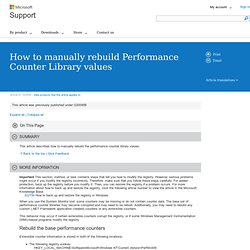
Important This section, method, or task contains steps that tell you how to modify the registry. However, serious problems might occur if you modify the registry incorrectly. Therefore, make sure that you follow these steps carefully. For added protection, back up the registry before you modify it. Then, you can restore the registry if a problem occurs. Optimizing File Replication over Limited-Bandwidth Networks using Remote Differential Compression. Optimizing File Replication over Limited-Bandwidth Networks using Remote Differential Compression Dan Teodosiu, Nikolaj Bjorner, Joe Porkka, Mark Manasse, and Y.
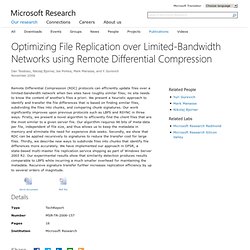
Gurevich November 2006 Remote Differential Compression (RDC) protocols can efficiently update files over a limited-bandwidth network when two sites have roughly similar files; no site needs to know the content of another's files a priori. We present a heuristic approach to identify and transfer the file differences that is based on finding similar files, subdividing the files into chunks, and comparing chunk signatures. Our work significantly improves upon previous protocols such as LBFS and RSYNC in three ways. How to configure DFSR file-type compression in Windows Server 2008. Browse by Tags - The Storage Team at Microsoft - File Cabinet Blog. Powershell Research - Manually Clearing the ConflictAndDeleted Folder in DFSR - Ask the Directory Services Team.
Ned here again.
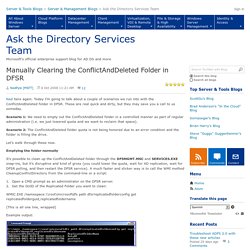
Today I’m going to talk about a couple of scenarios we run into with the ConflictAndDeleted folder in DFSR. These are real quick and dirty, but they may save you a call to us someday. Scenario 1: We need to empty out the ConflictAndDeleted folder in a controlled manner as part of regular administration (i.e. we just lowered quota and we want to reclaim that space). Scenario 2: The ConflictAndDeleted folder quota is not being honored due to an error condition and the folder is filling the drive. Let’s walk through these now. Emptying the folder normally It’s possible to clean up the ConflictAndDeleted folder through the DFSMGMT.MSC and SERVICES.EXE snap-ins, but it’s disruptive and kind of gross (you could lower the quota, wait for AD replication, wait for DFSR polling, and then restart the DFSR service). 1.
WMIC.EXE /namespace:\\root\microsoftdfs path dfsrreplicatedfolderconfig get replicatedfolderguid,replicatedfoldername (This is all one line, wrapped) Example output: How to configure DFS to use fully qualified domain names in referrals. By default, a Microsoft Distributed File System Namespace (DFSN) root referral reply to a DFS root referral query is in NetBIOS name format (\\<>\<>).
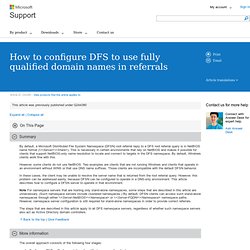
This is necessary in certain environments that rely on NetBIOS and makes it possible for clients that support NetBIOS-only name resolution to locate and connect to targets in the DFS namespace. By default, Windows clients work fine with this. However, some clients do not use NetBIOS. Two examples are clients that are not running Windows and clients that operate in an environment without WINS or that use DNS name suffixes. Those clients are incompatible with the default DFSN behavior. Windows: Make the Move to DFS. If you’re still using an older file and folder replication solution, it’s high time you moved over to the Distributed File System.
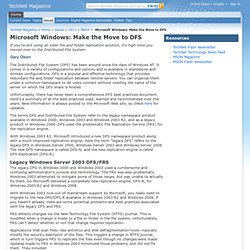
The Distributed File System (DFS) has been around since the days of Windows NT. It comes in a variety of configurations and options and is available in standalone and domain configurations. DFS is a popular and effective technology that provides redundant file and folder replication between remote servers. You can organize them under a common namespace to let users connect without needing the name of the server on which the DFS share is hosted. Unfortunately, there has never been a comprehensive DFS best practices document. Optional configuration for the DFS Replication Management Pack - The Storage Team at Microsoft - File Cabinet Blog.
My previous blog post explained how to configure the DFS Replication management pack.

The backlog monitoring feature of the management pack is disabled by default and requires some additional configuration. Happy SysAdm: DFSR replication report. Under Windows 2003/2008, to generate a diagnostic report for DFSR Replication, follow this easy steps: Click Start, point to Administrative Tools, and then click DFS Management: In the console tree, under the Replication node, right-click the replication group that you want to create a diagnostic report for, and then click Create Diagnostic Report:
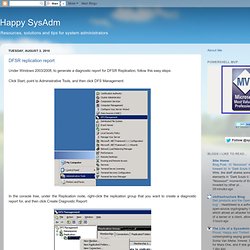
DFSR Does Not Replicate Temporary Files - TechNet Articles - Home - TechNet Wiki. This topic was originally posted to the AskDS blog and has been added to the wiki to allow for community editing.
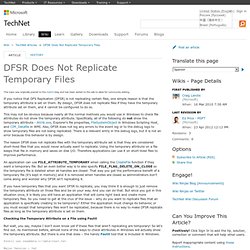
If you notice that DFS Replication (DFSR) is not replicating certain files, one simple reason is that the temporary attribute is set on them. By design, DFSR does not replicate files if they have the temporary attribute set on them, and it cannot be configured to do so. The reason DFSR does not replicate files with the temporary attribute set is that they are considered short-lived files that you would never actually want to replicate.
Using the temporary attribute on a file keeps that file in memory and saves on disk I/O. Therefore applications can use it on short-lived files to improve performance. Understanding DFS Replication "limits" - The Storage Team at Microsoft - File Cabinet Blog. [Updated on 11/27/06 to clarify areas where customers commonly have questions] The most frequent DFS Replication questions are about replication limits.

The answer is, as you might guess, not as simple as some arbitrary hard-coded limit. And just so we’re on the same page, I’m talking about the new replication engine in Windows Server 2003 R2, not File Replication Service. :-) Let’s start with the published tested DFS Replication limits: Each server can be a member of up to 256 replication groups.Each replication group can contain up to 256 replicated folders. Bullet 4 is a bit difficult to read. Designing Distributed File Systems. Welcome to the design guide for the Distributed File System solution in the Microsoft® Windows Server™ 2003 R2 operating system. This preliminary guide contains design recommendations for two scenarios, data publication and data collection, in which DFS Namespaces and DFS Replication are commonly used. (Additional recommendations and scenarios will be available as they are developed.) This guide is intended for IT planners and architects who are evaluating these technologies or creating a distributed file system design for their organizations.
How to manually decommission a root server that hosts a domain-based DFS root in Windows Server 2003.
Delegate the Ability to Manage DFS Replication. Published: August 17, 2007 Applies To: Windows Server 2008. How to configure DFSR file-type compression in Windows Server 2008. Deploying DFS Replication on a Windows Failover Cluster – Part II - The Storage Team at Microsoft - File Cabinet Blog. In the previous blog post we examined how to create a Windows Failover Cluster for Contoso. Now, let’s examine the steps involved in configuring a highly available file server on this new failover cluster. It is highly recommended to read the previous post first to gain valuable context about the sample deployment scenario that is referenced in the steps below. By virtue of configuring a high available file server on this cluster, the DFS Replication service also gets configured automatically for high availability.
A detailed step-by-step procedure follows. Deploying DFS Replication on a Windows Failover Cluster – Part III - The Storage Team at Microsoft - File Cabinet Blog. The previous posts in this series explained how to create a Windows Failover cluster and how to configure DFS Replication for high availability on that cluster respectively. Now, it is time to add the failover cluster as a member of a replication group. Get out and push! Getting the most out of DFSR pre-staging - Ask the Directory Services Team. Hi, Ned here again. Today I am going to explain the inner workings of DFSR pre-staging in Windows Server 2003 R2, debunk some myths, and hand out some best practices. Let’s get started. To begin, this is the last time I will say ‘pre-staging’. While the term is commonly used, it’s a bit confusing once you start mixing in terminology like the Staging directories. So from here in I will refer to this as ‘pre-seeding’ and hope that it enters your vernacular.
Pre-seeding is the act of getting a recent copy of replicated data to a new DFSR downstream node before you add that server to the Replicated Folder content set. How Initial Sync works. Replacing DFSR Member Hardware or OS (Part 3: N+1 Method) - Ask the Directory Services Team. Hello readers, Ned here again. In the previous two blog posts I discussed planning for DFSR server replacements and how to ensure you are properly pre-seeding data. Now I will show how to replace servers in an existing Replication Group using the N+1 Method to minimize interruption. Make sure you review the first two blog posts before you continue: Background. Browse by Tags - Ask the Directory Services Team. Configuring a read-only replicated folder on Windows Server 2008 R2. - The Storage Team at Microsoft - File Cabinet Blog. My previous post explained the concept of a read-only replicated folder.
Now, let us take a look at how to configure a read-only replicated folder in Windows Server 2008 R2.
The DACL of a DFS link is corrupted in Windows Server 2008, in Windows Vista, in Windows 7 or in Windows Server 2008 R2 if you use the Dfsutil.exe utility to export DFS configuration data from the DFS link. Consider the following scenario:You have a computer that is running Windows Server 2008, Windows Vista, Windows 7 or Windows Server 2008 R2.You use the Dfsutil.exe utility to export Distributed File System (DFS) configuration data from a DFS link.
Top 10 Common Causes of Slow Replication with DFSR - Ask the Directory Services Team. Hi, Ned again. DFS Troubleshooting. Importing the DFS Replication Management Pack - The Storage Team at Microsoft - File Cabinet Blog. Configuring the DFS Replication Management Pack - The Storage Team at Microsoft - File Cabinet Blog. Common DFSR Configuration Mistakes and Oversights - Ask the Directory Services Team. Tuning replication performance in DFSR (especially on Win2008 R2) - Ask the Directory Services Team. Hi all, Ned here again. There are a number of ways that DFSR can be tuned for better performance. This article will go through these configurations and explain the caveats. Even if you cannot deploy Windows Server 2008 R2 - for the absolute best performance - you can at least remove common bottlenecks from your older environments.
If you are really serious about performance in higher node count DFSR environments though, Win2008 R2’s 3rd generation DFSR is the answer. But there’s more you can do, especially in 2008 R2. Registry tuning All registry values are REG_DWORD (and in the explanations below, are always in decimal). DFSUtil in Windows Server 2003 VS DFSUtil in Windows Server 2008 - The Storage Team at Microsoft - File Cabinet Blog. 1. New Command Line Interface (CLI) DFSUtil.exe in Windows Server 2008 comes with a new CLI, which is based on Keywords, Required Parameters and Optional parameters instead of Switches and Arguments.
Microsoft’s Support Statement Around Replicated User Profile Data - Ask the Directory Services Team. [Note from Ned: this article was created and vetted by the Microsoft development teams for DFS Replication, DFS Namespaces, Offline Files, Folder Redirection, Roaming User Profiles, and Home Folders. Due to some TechNet publishing timelines, it was decided to post here in the interim. This article will become part of the regular TechNet documentation tree at a later date. The primary author of this document is Mahesh Unnikrishnan, a Senior Program Manager who works on the DFSR, DFSN, and NFS product development teams.
DFS Replication: Frequently Asked Questions (FAQ) The Basics of the Windows Server 2008 Distributed File System (DFS) - Jose Barreto's Blog. Recovering from Unsupported One-Way Replication in DFSR Windows Server 2003 R2 and Windows Server 2008. - Ask the Directory Services Team. Monitoring DFSR. Five Common Causes of “Waiting for the DFS Replication service to retrieve replication settings from Active Directory” - Ask the Directory Services Team. Installing the DFS Replication Management Pack - The Storage Team at Microsoft - File Cabinet Blog. Deploying DFS Replication on a Windows Failover Cluster – Part I - The Storage Team at Microsoft - File Cabinet Blog. One stop shopping for DFSR and DFSN recommended hotfixes - Ask the Directory Services Team. WDS and DFSR: Love at First Sync - Ask the Directory Services Team. An event ID 6002 that references Distributed File System replication is logged several times a day on a Windows Server 2003 R2-based computer.
You may not be able to add or remove additional namespace servers using the DFS management console in Windows Server 2003 R2. DFS Replication: What’s new in Windows Server™ 2008 R2 - The Storage Team at Microsoft - File Cabinet Blog. Read-Only Replication in R2 - Ask the Directory Services Team. DFS Technical Reference: Remote File Systems. DFS Server Target Prioritization. DFSR Replicated Folders. DFSR WMI Classes. Download details: Update for Best Practices Analyzer for File Services for Windows Server 2008 R2 x64 Edition (KB981111) List of currently available hotfixes for Distributed File System (DFS) technologies in Windows Server 2003 and in Windows Server 2003 R2. WDS and DFSR: Love at First Sync - Ask the Directory Services Team. Distributed File System.